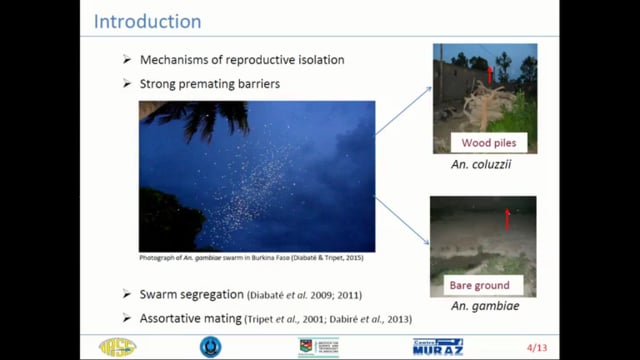ASTMH 2016, Abdoulaye Niang: “Assessment of the post-zygotic reproductive barriers between An. gambiae et An. coluzzii”
Collaborator(s): Research Institute of Health Sciences (IRSS), Burkina Faso
Published: 16/11/2016
In collaboration with ASTMH, Image Audiovisuals, and session presenters, MESA brings you this webcast from the 65th ASTMH annual meeting in Atlanta, November 2016.
Title: “Assessment of the post-zygotic reproductive barriers between An. gambiae et An. coluzzii“
Speaker: Abdoulaye Niang, Institut de Recherche en Sciences de la Santé, Burkina Faso
Session information: Scientific Session 144: “Mosquitoes: Molecular Genetics and Genomics”
Wednesday, 16 November, 1:45 – 3:30, Marriott – Room A602
Abstract:
Anopheles gambiae and An. coluzzii are two of the most important malaria vector species in sub-Saharan Africa. These recently-diverged sibling species are thought to be separated by strong assortative mating combined with selection against hybrids. At present, little is known about hybridization and the post-zygotic reproductive barriers between these cryptic taxa. Swarm segregation and assortative mating between An. gambiae and An. coluzzii were studied in the villages of VK7 and Soumousso, Western Burkina Faso. Natural swarms and pairs in copula were collected and genotyped, the proportion of intra and interspecific matings determined, and interspecific sperm transfer checked genetically. Females were collected resting indoors or as larvae and genotyped or sexed-and-genotyped via a multiplex PCR. Larval development and adult swarming success of hybrids were also estimated and compared to the parental species in semi-field experiment. A total of 3,687 males and 220 females were collected from 109 natural swarms and genotyped. Amongst 187 females captured in copula, 4 An. gambiae and one An. coluzzii females were found paired with and inseminated by heterospecific males. The lower overall hybridization rates observed at the larval and adult indoor stages compared to cross-mating rates support post-mating selection processes acting against hybrids. A total of 5,400 first instar larvae were transplanted in 36 cages in rice field with or without predators. Although no statistical difference was found between reciprocal hybrids and parental species in adult wing size, the development success varied significantly. In total 6,400 males of An. gambiae, An. coluzzii and the two reciprocal hybrids were randomly released in grand cages and swarm activities were daily monitored. A total of 428 males were captured in swarms but the frequencies of An. coluzzii (61.68%) followed by An. gambiae (37.62%) were significantly higher than those of the hybrids (0.70%). These findings are important for our understanding of the process of sympatric speciation in these important vector species.
THEMES: Basic Science | Vector Control



